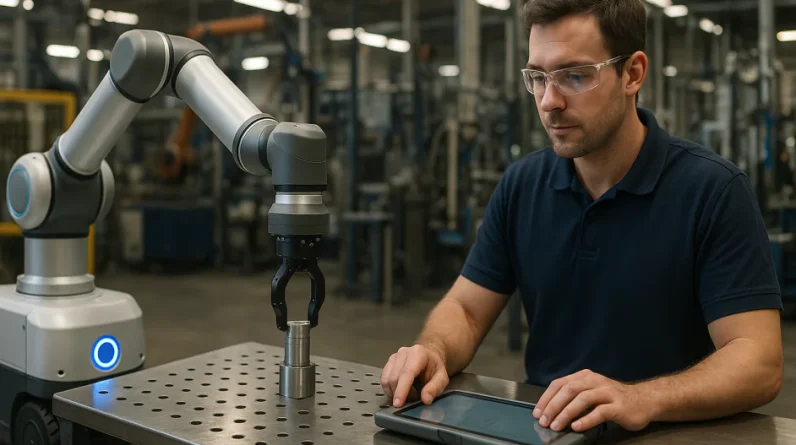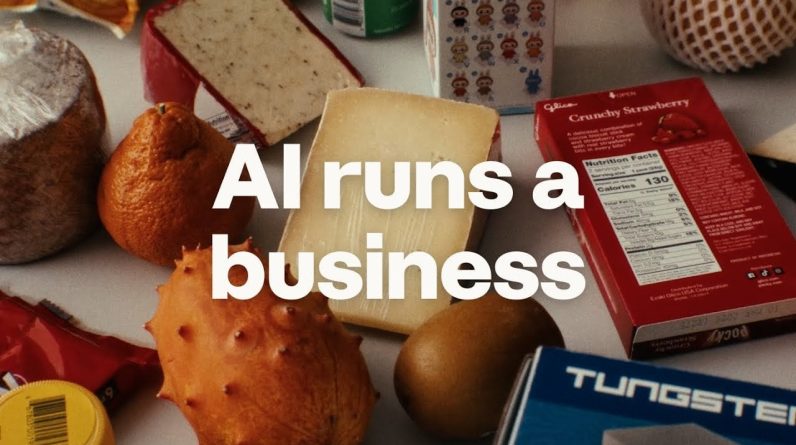
The benefits of embracing robotics in manufacturing are clear, with firms standing to gain enhanced efficiency and safety. However, pulling the trigger is still a challenge for decision makers. Complex manufacturing processes can create new and unforeseen problems when it comes to automation, but rather than burying issues under layer after layer of custom hardware and hardcoded systems, AI-enabled collaborative mobile robots working hand-in-hand with human workers can provide a much leaner solution.
The Collaborative Advantage: Where AI Meets Human Intuition
The global collaborative robot market is experiencing explosive growth, with sales projected to reach 735 thousand units by 2025. This boom is driven by the fact that most effective and successful automation implementations are those that enhance human capabilities rather than replace them.
While traditional industrial robots require safety barriers and massive investments, collaborative robots, or “cobots” for short, are designed to share their workspace with humans doing similar tasks. Their ease of use and ability to learn from humans allows them to be quickly adopted among existing operations, and the recent advancements in artificial intelligence are opening many more avenues for humans to program, deploy, and interact with them.
While old-school robotics demands a robust on-site support team, this approach is unworkable for most SMMs, who already face a significant expertise gap and struggle to attract and retain talent with automation skills. The shift to AI-powered collaborative systems closes this gap. With natural language and intuitive “learning by demonstration,” you can simply lead a robot along a factory floor, showing it a task. The need for specialized programming is eliminated, and with it, a primary barrier to adoption.
Safety First: How AI-Powered Cobots Actually Reduce Workplace Injuries
Safety is paramount in any manufacturing setting, whether workers are working with heavy material movement on a factory floor or simply arranging inventory in a warehouse. Injuries mean downtime, and downtime means lost revenue. With advancements in object-detection and recognition technologies, AI-powered autonomous robots can give employees peace of mind.
The safety advantage stems from multiple factors:
Advanced Collision Detection: Collaborative robots are built with features and functionalities that allow them to safely interact with human operators, including speed and separation monitoring (SSM) as a means to prevent collisions, and power and force limiting (PFL) to mitigate the severity of post-collision injuries.
Hazardous Task Automation: In instances where an AI-enabled robot takes over a repetitive task from a human operator, the risk of injury is fully negated. Dangerous, repetitive tasks are the highest risk for most factory workers, and are a prime example of a job whose outcome does not benefit from human involvement.
Real-time Environmental Awareness: Research has improved sensor technologies for better human detection and environmental awareness, reducing the likelihood of accidents and making AI cobots far more responsive to human presence.
Scalability Without Complexity: Growing Your Automation Strategy
Artificial intelligence also makes it possible for collaborative robots to be virtually endlessly scalable. In the case of material-moving robots that transport pallets from one location to another within a large facility, the number of units needed scales directly with demand. As the business grows, new robots can be added for a comparatively modest cost compared to a full-scale robotic overhaul.
This scalability manifests in multiple ways:
Task Flexibility: A single cobot can serve multiple purposes and tackle tasks of varying complexity depending on the need of the company. Many such robots can be fitted with accessories or instruments that allow them to be quickly repurposed.
Deployment Speed: Retrofitting a factory for full-scale automation could take months or even years, with extensive remodeling and installation of new power sources. AI cobots, on the other hand, can be added to a workflow and begin ROI within weeks or sooner.
Network Effects: Organizations that are unable or unwilling to revamp their processes can introduce a single cobot and, over time, expand to multiple units in a natural progression that poses a much lower learning curve.
Further, cobots are typically compact in size, making them a good fit for factory layouts with narrow aisles and fast-shifting floor plans. This adaptability is essential in the United States, where the manufacturing landscape is predominantly “brownfield” â filled with existing, older factories not designed for automation. Unlike “greenfield” projects in other countries where factories are built from scratch, brownfield automation requires solutions that integrate into existing, often varied, layouts without costly retrofitting. With their compact size and ability to work with existing assets and infrastructure, AI-powered cobots are uniquely suited to overcome this core challenge, making automation accessible without a complete operational overhaul.
Real-World Applications: Where AI-Enabled Cobots Excel
Collaborative AI-enabled robots are at their best when they are doing jobs that humans can’t do, or simply don’t want to. Tasks that demand extreme precision or intense repetition are both stressful and potentially painful, and human error can set back production. They are most often associated with manufacturing tasks like assembly lines or material handling, but they can enhance a company’s workforce in other ways:
Electronics Manufacturing: The electronics segment is expected to register the fastest CAGR from 2025 to 2030, attributed to the increasing complexity of electronic manufacturing processes that require high precision and repeatability.
Healthcare Support: Cobots with advanced AI are being considered in assisting healthcare providers with patient care. Relatively mundane tasks like medication delivery and aiding in rehabilitation exercises are obvious opportunities for cobots to excel.
Logistics and Warehousing: Robotics use in supply chains means material makes it to its destination faster and, thanks to AI, with greater accuracy. This is also an area where humans and robots can quickly and easily collaborate, performing similar tasks while humans provide guidance.
Looking Forward: The Future of Human-Robot Collaboration
AI-enabled collaborative robots represent a bright future of manufacturing automation. The future of cobots is promising, with their role continuing to expand across industries such as agriculture, healthcare, and logistics. And as AI and machine learning technologies evolve, it’s collaborative robots that will benefit the most from enhanced intelligence and greater autonomy.
As we look to the future, we can’t truly predict what new capabilities will be developed or on what timeline they will arrive. Still, researchers and industry leaders have been vocal about their desire for AI to learn directly from humans in a more natural way, retaining instructions and even asking questions when they are unsure of what to do.
Visual language understanding and natural language processing are a big deal for both artificial intelligence and collaborative robots, as they allow humans with no technical knowledge or coding experience to interact with these systems with little hesitation.
On the practical side, AI-powered robots that predict their own maintenance needs and can easily explain what they need and when they need it will make maintenance easier than ever before. Paired with internet access, a fleet of autonomous robots could even order repair supplies ahead of time, ensuring minimal downtime.
The future of manufacturing isn’t man vs. machine; it is a collaborative partnership. By pairing the ingenuity of skilled human workers with intelligent, adaptable machines, we can solve the labor crisis and unleash the full potential of our most vital manufacturers. This human-friendly path to automation is how we will build a more resilient, competitive, and productive industrial future for all.








